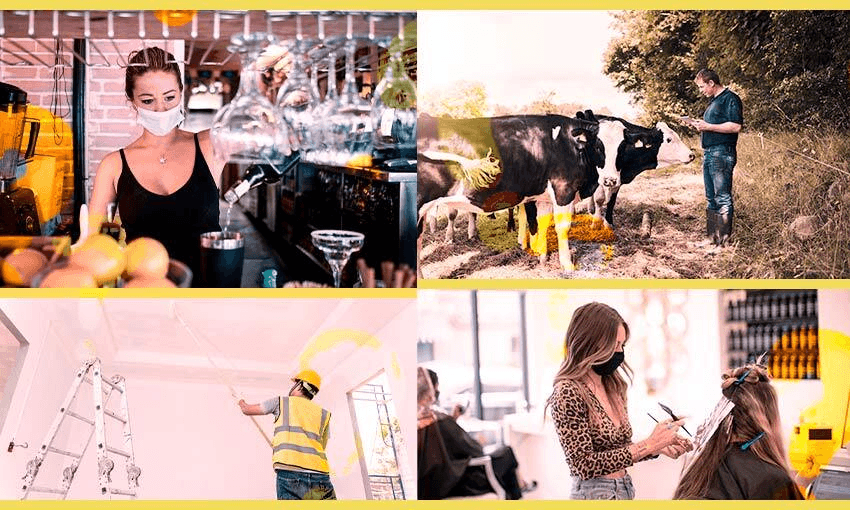As Covid embeds itself into our communities, catching the virus at work will become a real possibility for many more of us. But which occupations are by their nature the riskiest? Emma Vitz looks at the data.
Since the beginning of the pandemic, I’ve been acutely aware of how lucky I am to have a job that is largely unaffected by Covid. I work in an office, which means it’s easy to work from home, I’m rarely in a face-to-face interaction with people other than my coworkers, and because I work in the insurance industry, we haven’t lost much business either.
Of course, not everyone is so fortunate. Up until now, the main effect of the pandemic on people’s working lives in New Zealand has been a loss of work. But now that we’re transitioning to opening up in the face of community transmission, catching Covid at work will no longer be something only a small handful of healthcare workers and border workers are risking.
With this in mind, I wanted to take a look at the most common kinds of jobs that people have in New Zealand, and how they compare on a number of attributes that could increase the risk of catching Covid in the workplace.
The most common job in New Zealand is a sales assistant, a role held by 4.5% of the working population. Other common occupations include office manager, CEO/managing directors (presumably mostly of small businesses) and sales representatives.
Although I’m no expert in the finer details of Covid transmission, I think we’ve all learned a few things about the kinds of environments that make spread more likely. They include being indoors, being in close proximity to others, and having contact with a large number of people.
We can presume the government and public health officials considered similar factors in deciding to mandate Covid-19 vaccination for workers in sectors where vaccine certificates will be required for customers (such as hospitality, gyms and close-contact businesses such as hairdressers).
These factors are mentioned in WorkSafe’s guidelines for employers and are also likely to feature in a new legal risk-assessment process, announced yesterday, which employers can follow to decide whether they can require employees to be vaccinated.
With these workplace characteristics in mind, I decided to draw from databases that describe the work contexts of most occupations to better understand how conducive someone’s work environment is to spreading the virus.
In particular, I was interested in the need for physical proximity, the frequency of face-to-face interactions, how often someone dealt with external customers, and whether the work was conducted inside. Each of these characteristics was rated on a scale of 0 to 100, where 0 meant this never happened in the context of a particular job, and 100 meant that it was always a part of the work.
There are, of course, other things that matter as well – ventilation seems to be the sewage system of the 21st century – but we don’t have this information available at this stage.
So what does the information that we can access tell us? Click on the arrow below to sort jobs by industry.
Among the 50 most common jobs in New Zealand, the one with the highest total score across those four characteristics is a cafe or restaurant manager, with a total score of 376 out of 400 across the four metrics. They score extremely highly on being in an indoors environment, as well as being in close physical contact with others and being in contact with external customers, often in a face-to-face environment.
After cafe or restaurant manager, the jobs with the highest total scores across all four characteristics are hairdresser and nurse manager, with scores of 360 and 354 out of 400, respectively. Of course, following government announcements yesterday and earlier in the month, all these occupations will now be subject to vaccine mandates.
The job with the lowest total score across these four characteristics is a farm worker with a total score of 222.5. As well as not often working in an indoor environment, these workers score low on interactions with external customers and physical proximity to others. They do, however, engage in face-to-face interactions on a reasonably frequent basis.
Other jobs with low scores on these characteristics include trades workers and software engineers. Painters often work outside and rarely deal with external customers, while software engineers score low on physical proximity and interacting with external customers.
Overall, we can see that most occupations in New Zealand include some risk factors. Many people work in retail and hospitality, where close contact with large numbers of people in indoor settings could fan the flames of Covid transmission. While I wasn’t able to find data on the ages or ethnicities of people in each occupation, I think it’s safe to say that many of these higher-risk industries employ younger people, who are less likely to be fully vaccinated. Some may also employ more Māori or Pacific people, where vaccination rates are lower as well.
Whatever the industry in which they operate, employers need to become aware of the risk factors their work environments present to their employees and customers. As we ease out of lockdown, it’s no longer enough to assume Covid isn’t in our workplaces.



